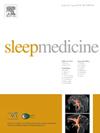Temporal link between cardiac arrhythmias and postoperative episodes of hypoxemia during nocturnal sleep in patients with obstructive sleep apnea syndrome
IF 3.4
2区 医学
Q1 CLINICAL NEUROLOGY
引用次数: 0
Abstract
Objective
Obstructive Sleep Apnea (OSA) is known to impact morbidity in the perioperative period through a postoperative exacerbation of respiratory events after general anesthesia. Cardiac arrhythmias may be triggered by respiratory and/or hypoxic events, therefore we searched for a temporal link between cardiac arrhythmias and episodes of hypoxemia following surgery under general anesthesia during the nocturnal sleep phase.
Methods
We included patients with a preoperative STOP-BANG questionnaire score between 3 and 8, planned for an elective surgery with general anesthesia. Patients had a preoperative sleep study (N0) and two postoperative sleep studies on the first (N1) and third (N3) night after surgery. Patients with mild-to-moderate OSA (apnea/hypopnea index (AHI) between 15 and 30) were compared to patients with an AHI <15 (nil-mild OSA group). Analysis was conducted to detect concomitant hypoxic episodes and cardiac arrhythmias as defined by auricular or ventricular premature complexes, ventricular or supraventricular arrhythmias.
Main results
39 patients comprised the moderate-OSA group and 12 patients the nil-mild OSA group. In the whole cohort, the incidence of cardiac arrhythmias associated with hypoxic episodes was increased at N3 compared to N0 (median: 1 event per hour of recorded time [IQR: 0; 4] vs 0 [0; 2], p = 0.04). We observed this in the OSA group compared to the nil-mild OSA group (1 [0; 4] vs 1 [0; 2], respectively; p = 0.02).
Conclusion
This study indicates that more cardiac arrhythmias associated with hypoxemic episodes can be observed in the postoperative night, in patients with moderate OSA. This reinforces the importance of preoperative screening for OSA.
Clinical trial registry
NCT02833662.
阻塞性睡眠呼吸暂停综合征患者夜间睡眠时心律失常与术后低氧血症发作之间的时间联系
众所周知,阻塞性睡眠呼吸暂停(OSA)会在全身麻醉后加重呼吸系统事件,从而影响围手术期的发病率。呼吸和/或低氧事件可能会诱发心律失常,因此我们研究了在夜间睡眠阶段进行全身麻醉手术后,心律失常与低氧血症发作之间的时间联系。患者进行了一次术前睡眠检查(N0),并在术后第一晚(N1)和第三晚(N3)进行了两次术后睡眠检查。轻度至中度 OSA(呼吸暂停/低通气指数(AHI)在 15 至 30 之间)患者与 AHI <15 患者(无轻度 OSA 组)进行了比较。主要结果 39 名患者组成中度 OSA 组,12 名患者组成轻度 OSA 组。在整个队列中,与缺氧发作相关的心律失常发生率在 N3 比 N0 时有所增加(中位数:每小时记录时间 1 次 [IQR: 0; 4] vs 0 [0; 2], p = 0.04)。我们在 OSA 组与轻度 OSA 组(分别为 1 [0; 4] vs 1 [0; 2];p = 0.02)中观察到了这一情况。临床试验登记号:NCT02833662。
本文章由计算机程序翻译,如有差异,请以英文原文为准。
求助全文
约1分钟内获得全文
求助全文
来源期刊

Sleep medicine
医学-临床神经学
CiteScore
8.40
自引率
6.20%
发文量
1060
审稿时长
49 days
期刊介绍:
Sleep Medicine aims to be a journal no one involved in clinical sleep medicine can do without.
A journal primarily focussing on the human aspects of sleep, integrating the various disciplines that are involved in sleep medicine: neurology, clinical neurophysiology, internal medicine (particularly pulmonology and cardiology), psychology, psychiatry, sleep technology, pediatrics, neurosurgery, otorhinolaryngology, and dentistry.
The journal publishes the following types of articles: Reviews (also intended as a way to bridge the gap between basic sleep research and clinical relevance); Original Research Articles; Full-length articles; Brief communications; Controversies; Case reports; Letters to the Editor; Journal search and commentaries; Book reviews; Meeting announcements; Listing of relevant organisations plus web sites.
 求助内容:
求助内容: 应助结果提醒方式:
应助结果提醒方式:


